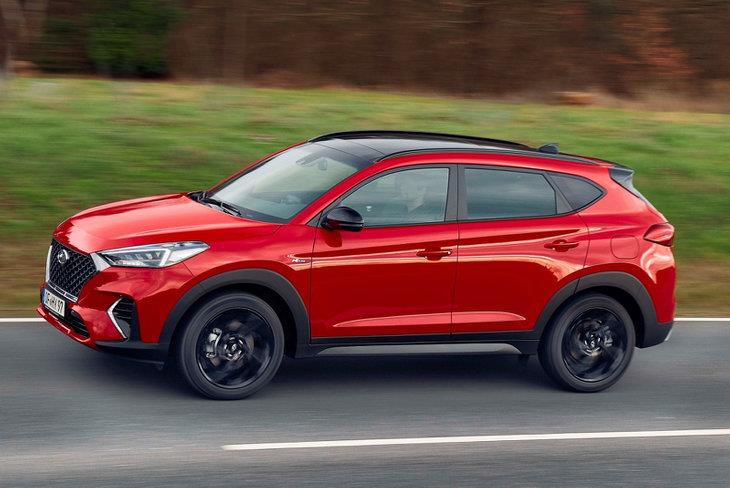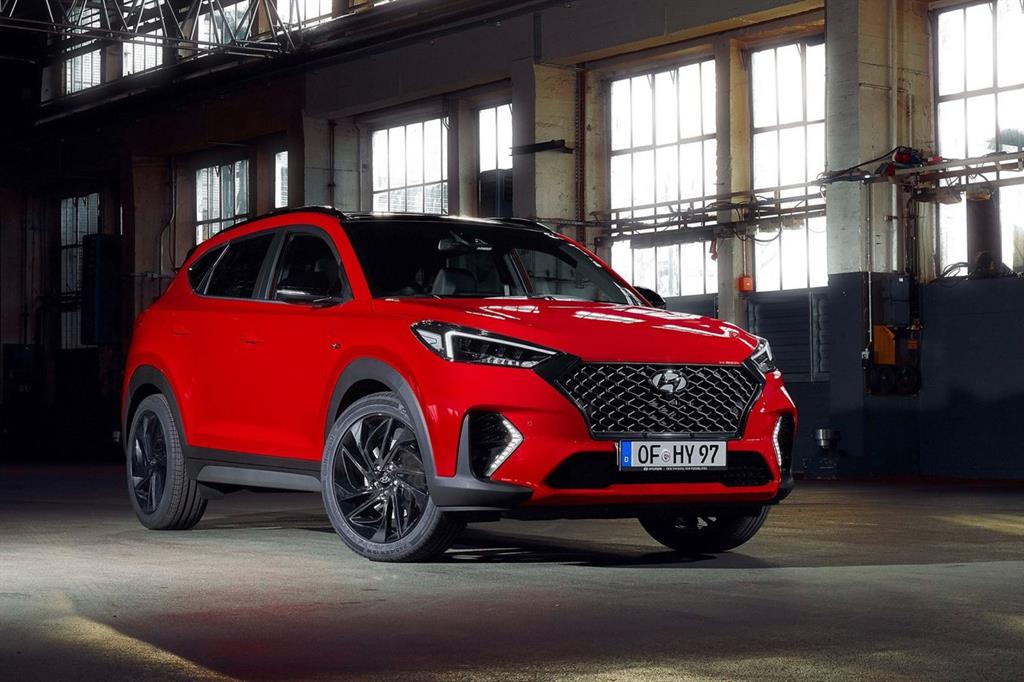Fast & Furious with more power
As a family car with surfeit kerb appeal, the Sport is in the ballpark.
For those with a penchant for a practical family SUV festooned with a Fast and Furious-style body kit and endowed with heightened power/torque outputs, Hyundai has delivered a solution - yet again.
There isn’t much in the way of subtlety to the exterior packaging of the Hyundai Tucson Sport.
Hyundai has piled on the body kit in an attempt to really sell you that Sport moniker. There’s a front splitter that protrudes from the front end, the side skirts jut out along the length of the flanks and, for good measure, the rear gets a bolt-on diffuser/bumper that houses 2 pairs of tailpipes. You can still have a tow bar fitted underneath that diffuser, if you like.
The new-look is rounded off with unique 19-inch black wheels.
Front bumper lip, side skirts and black wheels star in the Sport's new look.
The pre-facelift Tucson Sport was powered by a 1.6-litre turbo petrol motor mated with either a 6-speed manual or 6-speed automatic (DCT). For this iteration, the 6-speed manual version has been discontinued and a 2.0-litre turbo diesel derivative, with an 8-speed automatic transmission, has been added.
Both units develop 150 kW, but the latter develops 460 Nm of peak torque, compared with the petrol’s 300 Nm. The heightened outputs come courtesy of a software update and a pedal booster, which sharpens up the responsiveness of the throttle.
Interior-wise, everything remains standard; the spec is based on that of top-spec Elite derivatives.
Performance
Hyundai South Africa had a reasonably successful outing with the first iteration of the Tucson Sport. The Korean firm's local subsidiary commissioned the production of approximately 500 units of the car, all of which were snapped up. The success of the project clearly gave Hyundai more than enough motivation to produce a Sport version of its post-facelift family car.
Compared with its standard sibling, the petrol derivative's outputs have increased from 130 kW to 150 kW and 265 Nm to 300 Nm. The turbo diesel, meanwhile, sees its power and torque peaks boosted from 131 kW to 150 kW and 400 Nm to 460 Nm.
The Sport's upgraded figures come courtesy of the fitment of a Chip box plug-and-play upgrade, but, seeing as no performance testing has been conducted on the newcomers (at least not yet), it's unknown to what extent the Sport derivatives' acceleration times have been improved.
The Sports feel more than powerful enough and the biggest sensation of the performance gains comes from their ultra-responsive throttle pedals.
The rear diffuser still allows for a tow bar to be fitted.
It certainly requires a light foot to fend off the onslaught of front wheel spin when pulling away from traffic lights and intersection – and this is before you call up Sport mode, mind you.
The power and torque delivery, especially in the petrol-engined derivative, tends to easily overwhelm the front wheels (and, unlike with the previous Tucson Sport, there is no AWD version) and the net result is: torque steer. After that, the traction-control system sweats to regain control of the situation – clearly, a job it was never meant to (or had the training to deal with).
The turbo diesel version’s throttle response has been tapered slightly, probably because the R2.0's traction control processing unit might expire spontaneously if it had to deal with shepherding the distribution of more than 460 Nm. We jest, but you get the point. The diesel Sport feels a little easier to deal with and less prone to smoking its rubber at every pull-off.
The suspension setup remains standard, and that means that you don’t get any benefit from the power increase when the road gets twisty. The idea behind the Sport upgrade appears to be purely for aesthetic improvement and better straight-line performance.
The insides
The interior remains standard, pulled from the Elite spec models.
Being an Elite-spec derivative, the Tucson Sport is well equipped with a panoramic sunroof, leather seats, electric front-seat adjustment, plus a 7-inch touchscreen infotainment system that is both Apple Car play and Android Auto compatible. The safety spec is good too, with cross-traffic alert, blind-spot assist, vehicle stability control and 6 airbags.
Seeing that it is a Sport version, the flagship Tucson would have benefitted from the addition of paddle shifters, which would have increased the level of driver engagement the newcomers offer. The only options are: dual-clutch transmission for the petrol and conventional auto for the diesel. Overall, the Hyundai's interior cannot match its outlandish exterior.
Verdict
Now there is a turbo diesel option in the Tucson Sport range.
The Sport's racy body kit, eye-catching wheels and quartet of exhaust tips certainly add visual clout to the updated Tucson, but its lack of subtlety may not appeal to more discerning (read: conservative) family-car buyers. Compared with its standard siblings, the newcomer does, however, remain as practical as Elite-spec derivatives, even if some steering-wheel-mounted paddle shifters and (maybe even) some special contrast stitching would have lifted the general ambience and demeanour of the car to a level more befitting its name.
As for the power upgrades, they certainly have an effect, but probably more so than required. The Sport wheel spins at every opportunity by virtue of its over-sensitive throttle pedal. With more experience in the Tucson Sport, you may eventually learn to be very gentle with the throttle and save yourself from excessive tyre wear, not least amateurish pull always.
The N$60 000 increase in price (compared with Elite-spec derivatives) seems reasonable considering the exterior bolt-ons and, in terms of monthly instalments, the premium will probably result in monthly instalments of a few hundred Namibian dollar extra, at most. As a performance car, it’s a bit raw and unrefined, but as a family car with surfeit kerb appeal, it’s in the ballpark!
The Hyundai Tucson Sport comes with a 7-year/200 000 km warranty, 7-year/150 000 km roadside assistance and a 5-year/90 000 km service plan. - Hyundai
There isn’t much in the way of subtlety to the exterior packaging of the Hyundai Tucson Sport.
Hyundai has piled on the body kit in an attempt to really sell you that Sport moniker. There’s a front splitter that protrudes from the front end, the side skirts jut out along the length of the flanks and, for good measure, the rear gets a bolt-on diffuser/bumper that houses 2 pairs of tailpipes. You can still have a tow bar fitted underneath that diffuser, if you like.
The new-look is rounded off with unique 19-inch black wheels.
Front bumper lip, side skirts and black wheels star in the Sport's new look.
The pre-facelift Tucson Sport was powered by a 1.6-litre turbo petrol motor mated with either a 6-speed manual or 6-speed automatic (DCT). For this iteration, the 6-speed manual version has been discontinued and a 2.0-litre turbo diesel derivative, with an 8-speed automatic transmission, has been added.
Both units develop 150 kW, but the latter develops 460 Nm of peak torque, compared with the petrol’s 300 Nm. The heightened outputs come courtesy of a software update and a pedal booster, which sharpens up the responsiveness of the throttle.
Interior-wise, everything remains standard; the spec is based on that of top-spec Elite derivatives.
Performance
Hyundai South Africa had a reasonably successful outing with the first iteration of the Tucson Sport. The Korean firm's local subsidiary commissioned the production of approximately 500 units of the car, all of which were snapped up. The success of the project clearly gave Hyundai more than enough motivation to produce a Sport version of its post-facelift family car.
Compared with its standard sibling, the petrol derivative's outputs have increased from 130 kW to 150 kW and 265 Nm to 300 Nm. The turbo diesel, meanwhile, sees its power and torque peaks boosted from 131 kW to 150 kW and 400 Nm to 460 Nm.
The Sport's upgraded figures come courtesy of the fitment of a Chip box plug-and-play upgrade, but, seeing as no performance testing has been conducted on the newcomers (at least not yet), it's unknown to what extent the Sport derivatives' acceleration times have been improved.
The Sports feel more than powerful enough and the biggest sensation of the performance gains comes from their ultra-responsive throttle pedals.
The rear diffuser still allows for a tow bar to be fitted.
It certainly requires a light foot to fend off the onslaught of front wheel spin when pulling away from traffic lights and intersection – and this is before you call up Sport mode, mind you.
The power and torque delivery, especially in the petrol-engined derivative, tends to easily overwhelm the front wheels (and, unlike with the previous Tucson Sport, there is no AWD version) and the net result is: torque steer. After that, the traction-control system sweats to regain control of the situation – clearly, a job it was never meant to (or had the training to deal with).
The turbo diesel version’s throttle response has been tapered slightly, probably because the R2.0's traction control processing unit might expire spontaneously if it had to deal with shepherding the distribution of more than 460 Nm. We jest, but you get the point. The diesel Sport feels a little easier to deal with and less prone to smoking its rubber at every pull-off.
The suspension setup remains standard, and that means that you don’t get any benefit from the power increase when the road gets twisty. The idea behind the Sport upgrade appears to be purely for aesthetic improvement and better straight-line performance.
The insides
The interior remains standard, pulled from the Elite spec models.
Being an Elite-spec derivative, the Tucson Sport is well equipped with a panoramic sunroof, leather seats, electric front-seat adjustment, plus a 7-inch touchscreen infotainment system that is both Apple Car play and Android Auto compatible. The safety spec is good too, with cross-traffic alert, blind-spot assist, vehicle stability control and 6 airbags.
Seeing that it is a Sport version, the flagship Tucson would have benefitted from the addition of paddle shifters, which would have increased the level of driver engagement the newcomers offer. The only options are: dual-clutch transmission for the petrol and conventional auto for the diesel. Overall, the Hyundai's interior cannot match its outlandish exterior.
Verdict
Now there is a turbo diesel option in the Tucson Sport range.
The Sport's racy body kit, eye-catching wheels and quartet of exhaust tips certainly add visual clout to the updated Tucson, but its lack of subtlety may not appeal to more discerning (read: conservative) family-car buyers. Compared with its standard siblings, the newcomer does, however, remain as practical as Elite-spec derivatives, even if some steering-wheel-mounted paddle shifters and (maybe even) some special contrast stitching would have lifted the general ambience and demeanour of the car to a level more befitting its name.
As for the power upgrades, they certainly have an effect, but probably more so than required. The Sport wheel spins at every opportunity by virtue of its over-sensitive throttle pedal. With more experience in the Tucson Sport, you may eventually learn to be very gentle with the throttle and save yourself from excessive tyre wear, not least amateurish pull always.
The N$60 000 increase in price (compared with Elite-spec derivatives) seems reasonable considering the exterior bolt-ons and, in terms of monthly instalments, the premium will probably result in monthly instalments of a few hundred Namibian dollar extra, at most. As a performance car, it’s a bit raw and unrefined, but as a family car with surfeit kerb appeal, it’s in the ballpark!
The Hyundai Tucson Sport comes with a 7-year/200 000 km warranty, 7-year/150 000 km roadside assistance and a 5-year/90 000 km service plan. - Hyundai





Kommentaar
Republikein
Geen kommentaar is op hierdie artikel gelaat nie